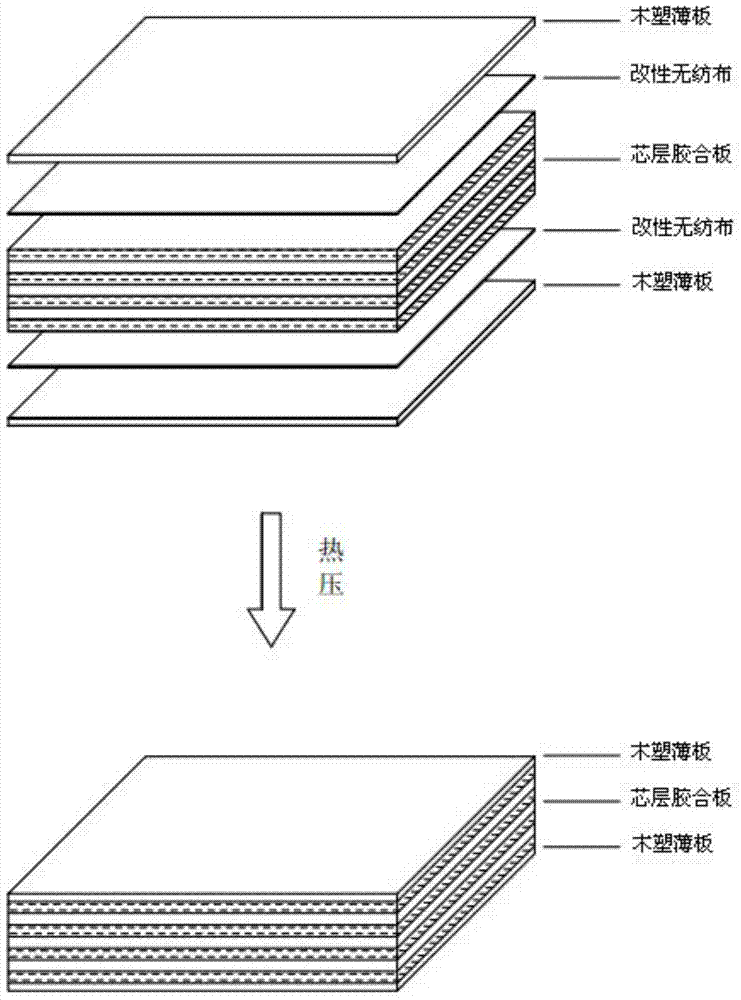Wood plastic composite material cladding plywood formwork and manufacturing method thereof
A wood-plastic composite and plywood technology, used in chemical instruments and methods, synthetic resin layered products, layered products, etc., can solve the problems of low strength and poor durability, and achieve strong acid resistance, not easy to be deformed by heat, and improve the bonding strength. Effect
- Summary
- Abstract
- Description
- Claims
- Application Information
AI Technical Summary
Problems solved by technology
Method used
Image
Examples
specific Embodiment approach 1
[0031] Embodiment 1: In this embodiment, a wood-plastic composite cladding plywood template is prepared from wood-plastic thin boards, modified non-woven fabrics and core plywood.
[0032] The surface of the wood-plastic composite clad plywood template prepared in this embodiment is flat and smooth, inert, easy and quick to demould, and has a small error in the flatness of the board surface. It has good water resistance, no delamination after long-term immersion in water, and good dimensional stability of the board. With the protection of wood-plastic veneer, the core plywood is not easy to absorb moisture and deform or swell. It solves the bonding problem between the large-format polar wood surface and the non-polar plastic surface. There is no water vapor generated during hot pressing, and hot pressing defects such as delamination and bubbling will not be caused; the wood is grafted by coupling agent The bonding strength of plywood and polyolefin is greatly improved; it can...
specific Embodiment approach 2
[0035] Embodiment 2: The difference between this embodiment and Embodiment 1 is that the wood-plastic thin board is prepared according to the following steps:
[0036] 1. Raw material preparation: Weigh 30-100 parts of thermoplastic, 20-200 parts of plant fiber powder, 20-100 parts of inorganic filler, 3-10 parts of coupling agent, 1-4 parts of lubricant, 1 ~4 parts of masterbatch and 3~10 parts of other fillers;
[0037] 2. Blending and granulation: Put the thermoplastics, plant fiber powder, inorganic fillers, coupling agents, lubricants, masterbatches and other fillers weighed in step 1 into a high-speed mixer, and control the temperature at 25 ° C ~ Mix at 150°C for 5min to 20min, then cool to room temperature to obtain a premix, then put the premix into a twin-screw granulator, control the temperature to 145°C to 235°C, and the speed to 30r / min to 100r / min , carry out granulation to obtain wood-plastic granules, and perform molding processing on the wood-plastic granules...
specific Embodiment approach 3
[0045] Specific embodiment three: the difference between this embodiment and specific embodiment one or two is that the modified non-woven fabric is prepared by adding grafting monomers and initiators into an organic solvent to prepare a mixed solution, and then the mixed solution Spray evenly on the non-woven fabric, and then place it in an oven at a temperature of 50°C to 100°C to dry for 10 minutes to 30 minutes to obtain a modified nonwoven fabric;
[0046] The raw material of the non-woven fabric is one or a mixture of several kinds of polypropylene, polyethylene, polyvinyl chloride and polystyrene, and when it is a mixture, it is mixed in any ratio;
[0047] Described grafting monomer is maleic acid, maleic anhydride, methyl methacrylate, acrylic acid, glycidyl methacrylate, ethyl acrylate or styrene monomers;
[0048] Described initiator is dicumyl peroxide, benzoyl peroxide, tert-butyl benzoyl peroxide or di-tert-butane peroxide;
[0049] Described organic solvent is ...
PUM
| Property | Measurement | Unit |
|---|---|---|
| particle diameter | aaaaa | aaaaa |
| thickness | aaaaa | aaaaa |
| thickness | aaaaa | aaaaa |
Abstract
Description
Claims
Application Information
 Login to View More
Login to View More - R&D
- Intellectual Property
- Life Sciences
- Materials
- Tech Scout
- Unparalleled Data Quality
- Higher Quality Content
- 60% Fewer Hallucinations
Browse by: Latest US Patents, China's latest patents, Technical Efficacy Thesaurus, Application Domain, Technology Topic, Popular Technical Reports.
© 2025 PatSnap. All rights reserved.Legal|Privacy policy|Modern Slavery Act Transparency Statement|Sitemap|About US| Contact US: help@patsnap.com

